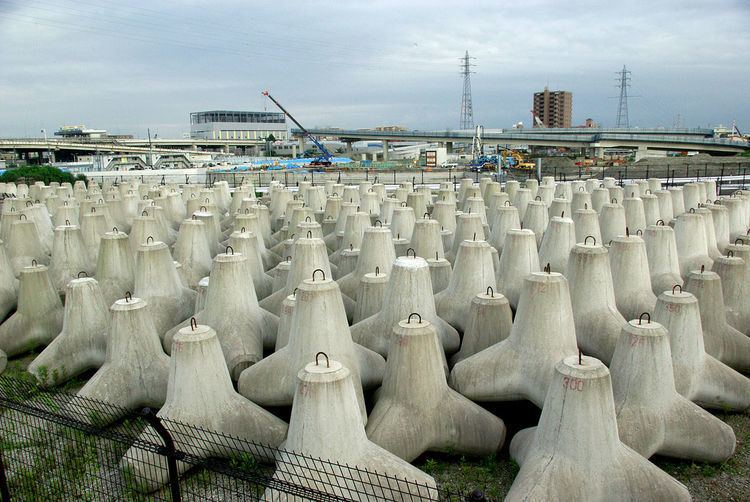 | ||
In coastal engineering, a tetrapod is a tetrahedral concrete structure used as armour unit on breakwaters. A tetrapod's shape is designed to dissipate the force of incoming waves by allowing water to flow around rather than against it, and to reduce displacement by allowing a random distribution of tetrapods to interlock.
Earlier barrier material used in breakwaters, such as boulders and conventional concrete blocks, tended to become dislodged over time by the force of the ocean constantly crashing against them. Tetrapods and similar structures are often numbered so any displacement that occurs can be monitored from photographs.
The unit was originally developed in 1950 by Laboratoire Dauphinois d'Hydraulique (now ARTELIA) in Grenoble, France. They are no longer protected by a patent, and are widely used all over the world, produced by many contractors.
The tetrapod inspired many similar concrete structures for use in breakwaters, including the Modified Cube (U.S., 1959), the Stabit (U.K., 1961), the Akmon (Netherlands, 1962), the Dolos (South Africa, 1963), the Stabilopod (Romania, 1969), the Seabee (Australia, 1978), the Accropode (France, 1981), the Hollow Cube (Germany, 1991), the A-jack (U.S., 1998), and the Xbloc (Netherlands, 2001), among others. In Japan, the word tetrapod is often used as a generic name for wave-dissipating blocks including other types and shapes.
Tetrapods and concrete have become a Japanese institution in modern times. Their manufacture and dispersal create jobs for Japanese citizens and contracts for construction companies. It is estimated that nearly 50 percent of Japan's 35,000 kilometer coastline has been covered or somehow altered by Tetrapods and other forms of concrete. Because of the proliferation of Tetrapods, tourists to the Hawaii-like island of Okinawa often find it difficult to find pristine beaches and unaltered shoreline, especially in the southern half of the island.
